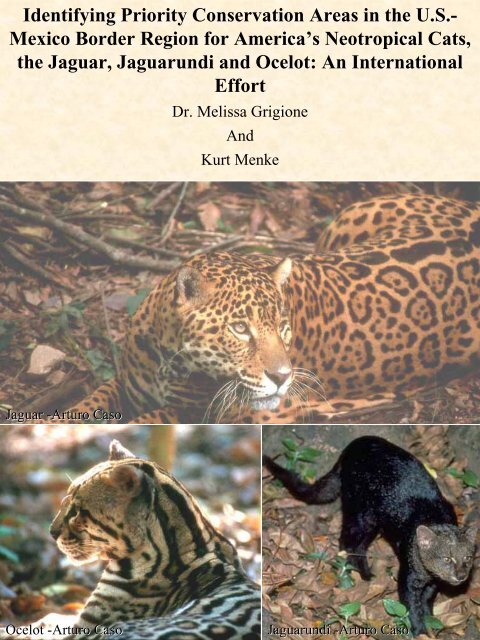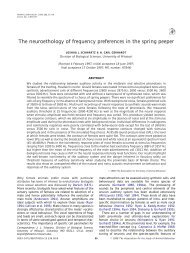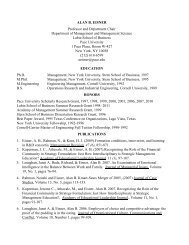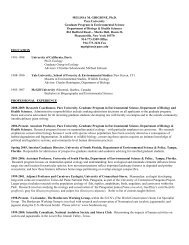Identifying Priority Conservation Areas in the U.S.- Mexico Border ...
Identifying Priority Conservation Areas in the U.S.- Mexico Border ...
Identifying Priority Conservation Areas in the U.S.- Mexico Border ...
Create successful ePaper yourself
Turn your PDF publications into a flip-book with our unique Google optimized e-Paper software.
<strong>Identify<strong>in</strong>g</strong> <strong>Priority</strong> <strong>Conservation</strong> <strong>Areas</strong> <strong>in</strong> <strong>the</strong> U.S.-<br />
<strong>Mexico</strong> <strong>Border</strong> Region for America’s Neotropical Cats,<br />
<strong>the</strong> Jaguar, Jaguarundi and Ocelot: An International<br />
Effort<br />
Jaguar -Arturo Arturo Caso<br />
Ocelot -Arturo Arturo Caso<br />
Dr. Melissa Grigione<br />
And<br />
Kurt Menke<br />
Jaguarundi -Arturo Arturo Caso
Background<br />
The <strong>Border</strong>cats Work<strong>in</strong>g Group (BWG)<br />
� Founded <strong>in</strong> 1998 to promote recovery and conservation of<br />
jaguars, ocelots and jaguarundis <strong>in</strong> <strong>the</strong> border region.<br />
� BWG is a cooperative concerned about <strong>the</strong> status of <strong>the</strong>se<br />
three felids <strong>in</strong> <strong>the</strong> nor<strong>the</strong>rn portion of <strong>the</strong>ir range.<br />
� BWG believes that:<br />
1. Cats as top predators are a fundamental component of<br />
border ecosystems<br />
2. Current <strong>Border</strong>cat research and conservation efforts are<br />
<strong>in</strong>sufficient<br />
3. Previous recovery efforts are <strong>in</strong>adequate for cat recovery<br />
4. Threats to cat survival are persistent.<br />
�BWG objectives <strong>in</strong>clude:<br />
1. Research<br />
2. Education regard<strong>in</strong>g <strong>the</strong> importance of cats and o<strong>the</strong>r<br />
carnivores for school children and private land owners<br />
3. Facilitation amongst groups and <strong>in</strong>dividuals <strong>in</strong>volved <strong>in</strong><br />
border region conservation
The Importance of <strong>Border</strong>cats<br />
� Sit at <strong>the</strong> top of <strong>the</strong> food cha<strong>in</strong> and act to ma<strong>in</strong>ta<strong>in</strong> ecosystem<br />
<strong>in</strong>tegrity via top down regulation<br />
�Additionally, recent studies have demonstrated that when<br />
species become endangered, <strong>the</strong>y persist <strong>in</strong> <strong>the</strong> periphery of<br />
<strong>the</strong>ir historic geographical ranges (Channell and Lomol<strong>in</strong>o,<br />
2000).<br />
�This pattern is contrary to conventional wisdom that range<br />
contractions accompany species decl<strong>in</strong>e such that populations<br />
persist <strong>in</strong> core portions of <strong>the</strong>ir historic geographical ranges.<br />
This recent <strong>in</strong>sight suggests that periphery populations of<br />
neotropical cats <strong>in</strong> <strong>the</strong> border region may <strong>in</strong> fact be more<br />
persistent than populations closer to <strong>the</strong> center of <strong>the</strong>ir<br />
distribution, <strong>in</strong> parts of Central and South America.<br />
Ocelot -Arturo Arturo Caso
The Problem<br />
�A detailed understand<strong>in</strong>g of cat distribution is an essential<br />
build<strong>in</strong>g block for conservation and educational activities.<br />
However, little is known about <strong>Border</strong>cat distribution and<br />
status.<br />
� They are difficult to observe due to <strong>the</strong>ir low densities.<br />
� They currently face numerous threats <strong>in</strong>clud<strong>in</strong>g: poach<strong>in</strong>g,<br />
land development and conversion, and construction of highways<br />
and <strong>in</strong>ternational bridges<br />
� Without a detailed understand<strong>in</strong>g of <strong>the</strong>ir distribution and<br />
habitat requirements <strong>in</strong> this portion of <strong>the</strong>ir range, adequate<br />
conservation and educational activities are not possible.<br />
Jaguarundi -Arturo Arturo Caso
Study Area
Our Solution<br />
Conducted Field Surveys 1998-00<br />
1. Rio Grande river adjacent to Big Bend National Park<br />
<strong>in</strong> Texas<br />
2. Nor<strong>the</strong>astern <strong>Mexico</strong> just south of border <strong>in</strong> <strong>the</strong> states<br />
of Coahuila, Nuevo León, and Tamaulipas.<br />
3. The Peloncillo and Chiricahua Mts of sou<strong>the</strong>astern<br />
AZ.<br />
Began Develop<strong>in</strong>g a Sight<strong>in</strong>gs Database<br />
Compil<strong>in</strong>g sight<strong>in</strong>gs for all three species <strong>in</strong> <strong>the</strong> border<br />
region from <strong>the</strong> early 1900’s to present<br />
Hold an Expert Workshop<br />
To recover endangered populations and ensure <strong>the</strong>ir<br />
long-term survival, it is imperative that <strong>the</strong> U.S. and<br />
<strong>Mexico</strong> work toge<strong>the</strong>r to identify current cat distribution<br />
and status <strong>in</strong> <strong>the</strong> nor<strong>the</strong>rn periphery of <strong>the</strong>ir range.
F<strong>in</strong>al Sight<strong>in</strong>gs Ga<strong>the</strong>red for each Species<br />
by Class<br />
I II III Total<br />
OCELOT<br />
Arizona 3 5 7 15<br />
Texas 121 97 74 292<br />
Tamaulipas 7 0 0 7<br />
Sonora 30 2 1 33<br />
Total<br />
JAGUARUNDI<br />
161 104 82 347<br />
Arizona 0 26 25 51<br />
New <strong>Mexico</strong> 0 0 1 1<br />
Texas 22 130 143 295<br />
Coahuila 0 0 1 1<br />
Durango 1 0 0 1<br />
Sonora 0 1 0 1<br />
Tamaulipas 2 0 0 2<br />
Total<br />
JAGUAR<br />
25 157 170 352<br />
Arizona 20 13 49 82<br />
New <strong>Mexico</strong> 8 2 1 11<br />
Texas 7 2 0 9<br />
San Luis Potas 1 0 0 1<br />
Sonora 56 0 0 56<br />
Tamaulipas 5 1 0 6<br />
Total 97 18 50 165<br />
A total of 864 sight<strong>in</strong>gs with latitude and longitude were ga<strong>the</strong>red dur<strong>in</strong>g <strong>the</strong> study
Expert Workshop<br />
In December 2003, 29 experts from seven U.S. states and four Mexican<br />
states were <strong>in</strong>vited to attend a GIS based habitat mapp<strong>in</strong>g workshop.<br />
Experts were asked to:<br />
� Identify important Cat <strong>Conservation</strong> Units (CCU’s)<br />
� Identify Cat <strong>Conservation</strong> Corridors (CCC’s)<br />
� Identify needed or exist<strong>in</strong>g underpasses<br />
� Characterize <strong>the</strong> CCU’s and CCC’s<br />
� Give additional sight<strong>in</strong>g <strong>in</strong>formation not identified previously<br />
� Identify areas need<strong>in</strong>g additional study
Coverage of Study Area by Experts<br />
� Each expert was asked to del<strong>in</strong>eate his or her area of<br />
knowledge for each species onto maps of <strong>the</strong> border<br />
region.<br />
�Historic ranges of all three species were well covered with<br />
some small exceptions<br />
�More experts for Jaguar (14) than Ocelot (9) or Jaguarundi (8)<br />
�SE Arizona represented <strong>the</strong> most expertise
Weight<strong>in</strong>g Scheme for CCU’s and CCC’s<br />
�Each expert ranked <strong>the</strong>se factors <strong>in</strong> terms of <strong>the</strong>ir relative<br />
importance for <strong>the</strong> survival of <strong>the</strong> species. These values were<br />
summed and used to derive <strong>the</strong> percentage weight for each factor.<br />
�This provided a measure of importance of each factor for each<br />
species.<br />
CCU’s JAGUAR OCELOT JAGUARUNDI<br />
CCU Connectivity 17.2 15.4 17<br />
Habitat Quality 18.1 22.5 21.5<br />
CCU Size 17.8 17.6 13.4<br />
Cat Hunt<strong>in</strong>g by Humans 11.1 6.1 8<br />
Prey Hunt<strong>in</strong>g by Humans 4.1 1 2.8<br />
Cat Population Status 10.5 13.6 13.9<br />
Road Threats 1.4 8 7.3<br />
Effectiveness of Protection 5.3 2.5 4.3<br />
Human Density 14.5 13.3 11.8<br />
TOTAL 100.00% 100.00% 100.00%<br />
CCC’s JAGUAR OCELOT JAGUARUNDI<br />
CCC Connectivity 18.9 15.7 18.3<br />
Habitat Quality 12.5 13.9 13.9<br />
CCC Width 7.6 7.8 7.8<br />
CCC Length 10.5 7.3 7.6<br />
Cat Hunt<strong>in</strong>g by Humans 7.9 4.3 5.4<br />
Prey Hunt<strong>in</strong>g by Humans 3.9 1.1 1.6<br />
Corridor Gaps 10.3 12.1 9.5<br />
Road Threats 2.2 11.3 6.7<br />
Effectiveness of Protection 4.5 4.8 7.6<br />
Human Density 14.6 11.6 12.1<br />
Value of Core <strong>Areas</strong> 7.1 10.1 9.5<br />
TOTAL 100.00% 100.00% 100.00%
Weight<strong>in</strong>g Scheme Applied to CCU’s and<br />
CCC’s<br />
�The author<strong>in</strong>g expert for each CCU and CCC was asked to fill<br />
out a data sheet for <strong>the</strong> area.<br />
�The author ranked each factor as good for cats, bad for cats or<br />
somewhere <strong>in</strong> <strong>the</strong> middle for each unit.<br />
�These ranks were assigned a value of three, zero or one,<br />
respectively and multiplied by <strong>the</strong> weight<strong>in</strong>g scheme.<br />
�These data allowed us to rank units and corridors <strong>in</strong> terms of<br />
relative importance to <strong>the</strong> survival of <strong>the</strong> species.<br />
�Very High<br />
�High<br />
�Moderate
Protected Status<br />
CCU’s and CCC’s were <strong>in</strong>tersected with protected areas from <strong>the</strong><br />
International Union for <strong>Conservation</strong> of Nature and Natural<br />
Resources (IUCN - http://www.iucn.org/ )<br />
I. Wilderness Area: protected area managed ma<strong>in</strong>ly for<br />
wilderness protection<br />
II. National Park: protected area managed ma<strong>in</strong>ly for<br />
ecosystem protection and recreation<br />
III. Natural Monument: protected area managed ma<strong>in</strong>ly for<br />
conservation of specific natural features<br />
IV. Habitat/Species Management Area: protected area<br />
managed ma<strong>in</strong>ly for conservation through management<br />
<strong>in</strong>tervention<br />
V. Protected Landscape/Seascape: protected area managed<br />
ma<strong>in</strong>ly for landscape/seascape conservation and recreation<br />
VI. Managed Resource Protected Area: protected area<br />
managed ma<strong>in</strong>ly for <strong>the</strong> susta<strong>in</strong>able use of natural<br />
ecosystems
Cat <strong>Conservation</strong> Units (CCU’s)<br />
IUCN Protected Status (km2)<br />
CCU's Total (km2) I II III IV V VI Protected (km2) % Protected<br />
Ocelot East 45,387 0 6 0 161 0 924 1,091 2.4<br />
Ocelot West 31,535 0 0 0 0 0 601 601 1.9<br />
Jaguar East 17,931 0 317 0 0 0 0 317 1.8<br />
Jaguar West 102,530 5,908 0 26 0 18 14,297 20,249 19.8<br />
Jaguarundi East 68,407 168 1,100 60 0 0 0 1,328 1.9<br />
Total (km2) 265,790 6,076 1,423 86 161 18 15,822 23,586 8.9<br />
� 21 CCU’s were identified total<strong>in</strong>g 265,790 km 2<br />
� 67% are on <strong>the</strong> Mexican side of <strong>the</strong> border and 52% are<br />
for <strong>the</strong> ocelot.<br />
� Twelve study areas were identified, eight be<strong>in</strong>g with<strong>in</strong><br />
50km of <strong>the</strong> <strong>in</strong>ternational border.<br />
� On average only 8.9% of <strong>the</strong> units currently have some<br />
level of protection.<br />
� Most of this protected land (86%) is represented by<br />
jaguar units on <strong>the</strong> U.S. side of <strong>the</strong> border <strong>in</strong> <strong>the</strong><br />
western bioregion.<br />
� 67% of <strong>the</strong> area currently protected with<strong>in</strong> CCU’s are only<br />
class VI, <strong>the</strong> lowest level of protection identified by<br />
<strong>the</strong> IUCN.
Cat <strong>Conservation</strong> Corridors (CCC’s)<br />
IUCN Protected Status (km2)<br />
CCC's Total (km2) I II III IV V VI Protected (km2) % Protected<br />
Ocelot East 5,421 0 0 0 0 0 0 0 0<br />
Ocelot West 0 0 0 0 0 0 0 0 0<br />
Jaguar East 2,712 0 128 0 0 0 0 128 4.7<br />
Jaguar West 3,320 0 0 0 0 0 0 0 0<br />
Jaguarundi East 0 0 0 0 0 0 0 0 0<br />
Total (km2) 11,453 0 128 0 0 0 0 128 1.1<br />
� Seven CCC’s were identified total<strong>in</strong>g 11,453km 2 .<br />
� None of <strong>the</strong>se connect CCU’s on opposite sides of <strong>the</strong><br />
<strong>in</strong>ternational border.<br />
� Twelve study areas were also identified, 50% of which<br />
connect areas across <strong>the</strong> <strong>in</strong>ternational border.<br />
� There were no CCC’s identified for jaguarundi.<br />
� Only one CCC <strong>in</strong> <strong>the</strong> study currently has protection.
Jaguar East
Jaguar West
Ocelot East
Ocelot East<br />
<strong>Border</strong> Area
Ocelot West
Jaguarundi East
Conclusions<br />
� Lack of current protection is alarm<strong>in</strong>g<br />
� There is a lack of understand<strong>in</strong>g of all three species along <strong>the</strong><br />
border itself<br />
� More research is needed, especially <strong>in</strong> <strong>the</strong> study areas<br />
identified, to <strong>in</strong>crease our understand<strong>in</strong>g of neotropical cat<br />
status and <strong>the</strong>ir ecological requirements<br />
� The two ma<strong>in</strong> benefits from this study were:<br />
1. The identification of focal areas for future research and<br />
habitat conservation measures<br />
2. The formation of an <strong>in</strong>ternational network of concerned<br />
scientists and conservationists.





